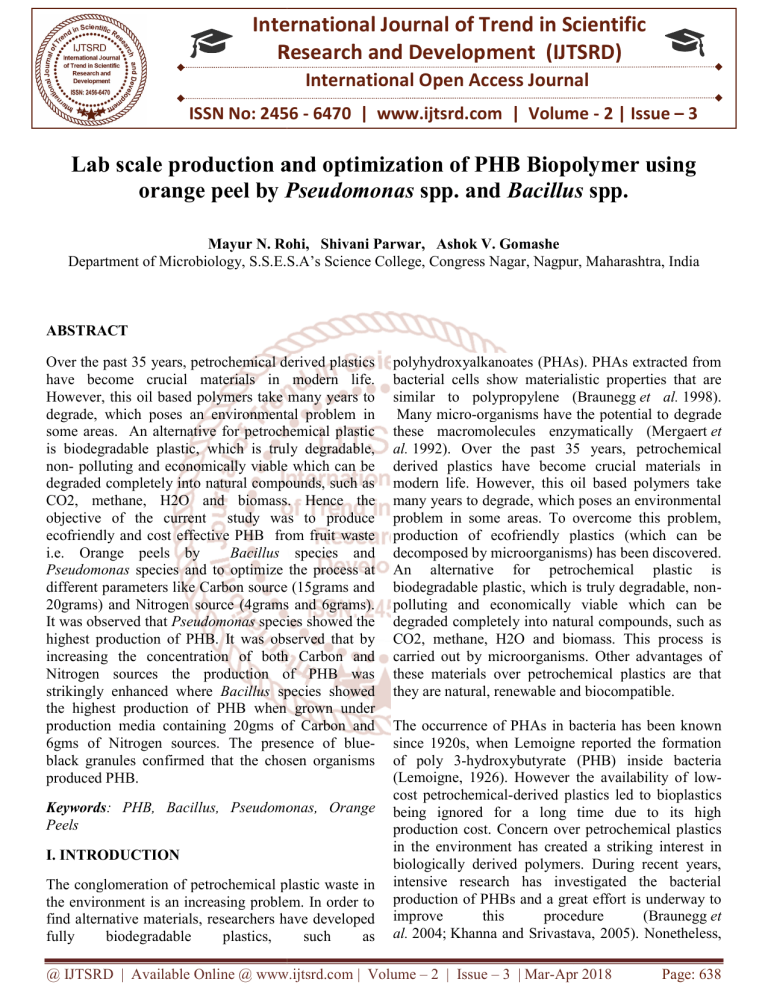
International Journal of Trend in Scientific
Research and Development (IJTSRD)
International Open Access Journal
ISSN No: 2456 - 6470 | www.ijtsrd.com | Volume - 2 | Issue – 3
Lab scale production and optimization of PHB Biopolymer using
orange peel by Pseudomonas spp. and Bacillus spp.
Mayur N. Rohi
Rohi, Shivani Parwar, Ashok V. Gomashe
Department of Microbiology, S.S.E.S.A’s Science College, Congress Nagar, Nagpur, Maharashtra, India
ABSTRACT
Over the past 35 years, petrochemical derived plastics
have become crucial materials in modern life.
However, this oil based polymers take many years to
degrade, which poses an environmental problem in
some areas. An alternative for petrochemical plastic
is biodegradable plastic, which is truly degradable,
non- polluting and economically viable which can be
degraded completely into natural compounds, such as
CO2, methane, H2O and biomass. Hence the
objective of the current study was to produce
ecofriendly and cost effective PHB from fruit waste
i.e. Orange peels by
Bacillus species and
Pseudomonas species and to optimize the process at
different parameters like Carbon source (15grams and
20grams) and Nitrogen source (4grams and 6grams).
It was observed that Pseudomonas species showed the
highest production of PHB. It was observed that by
increasing the concentration of both Carbon and
Nitrogen sources the production of PHB was
strikingly enhanced where Bacillus species showed
the highest production of PHB when grown under
production media containing 20gms of Carbon and
6gms of Nitrogen sources. The presence of blue
blueblack granules confirmed that the chosen organisms
produced PHB.
Keywords: PHB, Bacillus, Pseudomonas
Pseudomonas, Orange
Peels
I. INTRODUCTION
The conglomeration of petrochemical plastic waste in
the environment is an increasing problem. In order to
find alternative materials, researchers have developed
fully
biodegradable
plastics,
such
as
polyhydroxyalkanoates (PHAs). PHAs extracted from
bacterial cells show materialistic
material
properties that are
similar to polypropylene (Braunegg
(
et al. 1998).
Many micro-organisms
organisms have the potential to degrade
these macromolecules enzymatically (Mergaert
(
et
al. 1992). Over the past 35 years,
ye
petrochemical
derived plasticss have become crucial materials in
modern life. However, this oil based polymers take
many years to degrade, which poses an environmental
problem in some areas. To overcome this problem,
production of ecofriendly plastics (which can be
decomposed
ecomposed by microorganisms) has been discovered.
An alternative for petrochemical plastic is
biodegradable plastic, which is truly degradable, nonnon
polluting
luting and economically viable which can be
degraded completely into natural compounds,
co
such as
CO2, methane, H2O and biomass. This process is
carried out by microorganisms. Other advantages of
these materials over petrochemical plastics are that
they are natural, renewable and biocompatible.
The occurrence of PHAs in bacteria has been known
since 1920s, when Lemoigne reported the formation
of poly 3-hydroxybutyrate (PHB) inside bacteria
(Lemoigne, 1926). However the availability of lowcost petrochemical-derived
derived plastics led to bioplastics
bioplastic
being ignored for a long time due to its high
production cost. Concern over petrochemical plastics
in the environment
vironment has created a striking interest in
biologically derived polymers. During recent years,
intensive research has investigated the bacterial
production of PHBss and a great effort is underway to
improve
this
procedure
(Braunegg
(
et
al. 2004; Khanna and Srivastava,
Srivastava 2005). Nonetheless,
@ IJTSRD | Available Online @ www.ijtsrd.com | Volume – 2 | Issue – 3 | Mar-Apr
Apr 2018
Page: 638
International Journal of Trend in Scientific Research and Development (IJTSRD) ISSN: 2456-6470
the PHA production price is still far above the price of
conventional plastics (Salehizadeh and Van
Loosdrecht, 2004).
PHB
is
produced
by microorganisms (such
as Ralstonia
eutrophus, Methylobacterium
rhodesianum or Bacillus megaterium) apparently in
response to conditions of physiological stress
( Ackermann et al. 1995) mainly in conditions where
nutrients are limited. The polymer is primarily a
product
of carbon assimilation
(from glucose or starch) and is employed by
microorganisms as a form of energy storage molecule
to be metabolized when other common energy sources
are not available.
Most commercial plastics are synthetic polymers
derived from petrochemicals. They tend to
resist biodegradation. PHB-derived plastics are
attractive because they are compostable and derived
from
renewables
and
are
bio-degradable.
Polyhydroxyalkanoates (PHAs), as one of these
alternatives, have attracted much attention in recent
years due to their varied mechanical properties,
biocompatibility and biodegradability. They are
synthesized and stored intracellularly by a wide
variety of bacteria such as Bacillus sp., Pseudomonas
sp., Azobacterium sp. etc.
Even though PHB is not water soluble, but it is 100%
biodegradable in the environment when proper
conditions such as sunlight, moisture, and oxygen are
made available. Production of PHB and other
bioplastics however are known to be very expensive
since they are involving expensive carbon source.
Apart from that, both the upstream processing and
downstream processing also contributed to the high
production cost. Therefore, studies have been actively
conducted to find the suitable alternative to replace
the original glucose. Hence the present study has been
framed to analyze and utilize agricultural waste for
production of PHB by Bacillus sp. and Pseudomonas
sp.
II. Materials and Methods
A. Culture Collection
Bacillus sp. and Pseudomonas sp. were procured
from the laboratory and the culture ere maintained
at 4̊C for further studies.
B. Collection of Orange Peels
Orange peels were collected from the fruit juice
vendors situated at Nagpur region Maharashtra
(India) and were taken to the laboratory in zip
lock sterile polythene bags.
C. Preparation of Extract
Orange peels were grounded finely under sterile
conditions, suspended in distilled water (10 g /100
ml) in 4 conical flasks each and then kept at room
temperature for seven days. Then extract was
filtered and the filtrate was sterilized at 110 0C for
10 minutes (Figure 1).
D. Supplementation of Extract with Carbon and
Nitrogen source
Prior to inoculation, Carbon source was
supplemented to the sterile filtrate to each flask.
All the four flasks (G) were supplemented with
10grams of Glucose each and only two flasks
were supplemented with 2 grams of amino acids
lysine and histidine each additionally (G + N).
Two flasks were inoculated with the cultures of
Bacillus sp. (G, G + N) and two with
Pseudomonas sp. (G, G+N) each. The inoculated
flasks were then incubated at 37̊C for 7 days
(Figure 2).
E. Bacterial Staining
After incubation, a loopful of culture was taken
from the flasks on the slide and the cells were
stained with Sudan black (5 %) and kept for 5
minutes. The slide was washed with tap water.
The Slide was flooded with counter stain
Safranine (5%) and kept for 5 minutes. The slide
was then washed off with tap water and the
organisms were observed under microscope.
F. Extraction and Purification of PHB
The Filtrate was subjected to extraction using
Centrifugation technique. The Filtrate was
centrifuged at 4500 rpm for 20 minutes. The
supernatant was discarded and the pellet was
stored separately at 4̊C. For purification the pellet
was treated with equal quantity of sodium hypo
chlorite and the mixture was centrifuged at 5000
rpm for 15 minutes. Then the pellet was washed
@ IJTSRD | Available Online @ www.ijtsrd.com | Volume – 2 | Issue – 3 | Mar-Apr 2018
Page: 639
International Journal of Trend in Scientific Research and Development (IJTSRD) ISSN: 2456-6470
with distilled water and acetone respectively.
After washing the pellet was dissolved in 5 ml of
boiling chloroform and allowed to evaporate on
sterile glass plate. After evaporation the dry
powder was collected and weighed.
G. Optimization
The process of PHB production was optimized by
considering different parameters like Carbon
(15grams and 20grams) and Nitrogen (4grams and
6grams) sources at varied concentration. The
procedure for optimizing the process of PHB
production was similar as implemented above for
its production.
III. Result and Discussion
The bioplastics have gained much attention in the
recent scenario due to its ecofriendly effects. PHB is
one of the components in the preparation of
bioplastics. Bioplastics are preferred over petrochemical plastics as it can be degraded and does not
create any polluting effects. Also the production of
PHB is economic and serves ease of process
modification, optimization and purification. Hence the
objective of the current study was to produce
ecofriendly and cost effective PHB from fruit waste
i.e. Orange peels by
Bacillus species and
Pseudomonas species and to optimize the process at
different parameters like Carbon source (15grams and
20grams) and Nitrogen source (4grams and 6grams).
When the selected isolates of Bacillus and
Pseudomonas species were allowed to grow in the
production media containing Orange peels
supplemented with both Carbon and Nitrogen sources
showed the best production of PHB granules.
Specifically Pseudomonas species showed the highest
production of PHB (Table 1).
The process of PHB production was optimized by
considering different parameters like Carbon
(15grams and 20grams) and Nitrogen (4grams and
6grams) sources utilizing both Bacillus species and
Pseudomonas species. It was observed that by
increasing the concentration of both Carbon and
Nitrogen sources the production of PHB was
strikingly enhanced where Bacillus species showed
the highest production of PHB when grown under
production media containing 20gms of Carbon and
6gms of Nitrogen sources (Table 2, 3). From the
staining technique, it was confirmed that PHB was
produced by the bacterial cell (Figure 5).
In the current study, orange peel was used as the main
substrate. The media was prepared and PHB
production was carried out. The flasks were checked
for the production of PHB by staining the mass with
Sudan black (Figure 3,4). The presence of blue- black
granules confirmed that the chosen organisms
produced PHB. The PHB was then extracted and
quantified. The similar results were reported by Sreeju
et al. (2011); Sukan et al. (2014).
IV. Conclusion
In this study, orange peel was used as a sole carbon
source in the medium optimized for (PHB)
production. These results clearly show that orange
peel which is an abundant and unutilised agroindustrial waste material; it is a very attractive and an
economically feasible carbon source for the
production of PHAs. In the current study we have
reported the production of (PHB) using orange peel as
a sole carbon source with a very simple pre-treatment
method. Also by optimizing the production process
we can conclude that by increasing the concentrations
of carbon and nitrogen sources in combination, the
PHB productivity increases.
Although the strain selected was not a high PHB
producer, the results obtained indicated that the
presence of orange peel as a medium component
promoted (PHB) production significantly. Further
research is needed in downstream processing and
further industrial strain selection in order to make this
process more feasible for commercial production.
@ IJTSRD | Available Online @ www.ijtsrd.com | Volume – 2 | Issue – 3 | Mar-Apr 2018
Page: 640
International Journal of Trend in Scientific Research and Development (IJTSRD) ISSN: 2456-6470
TABLE I. PRODUCTION OF PHB BY PSEUDOMONAS AND BACILLUS SPECIES USING ORANGE PEELS
Sr. No.
Name of Organism
Concentration
glucose (G) source
10 g
of Concentration of glucose Productivity
(G) + nitrogen (N) source (g/100ml)
_
1.35 g
Flask 1.
Flask 2.
Pseudomonas
spp.
Pseudomonas spp.
_
10g + 2g
1.40 g
Flask 3.
Flask 4
Bacillus spp.
Bacillus spp.
10 g
-
_
10+ 2g
0.96 g
1.12g
TABLE II.OPTIMIZATION OF PHB PRODUCTION BY PSEUDOMONAS SPECIES IN ORANGE PEEL AT
DIFFERENT GLUCOSE AND NITROGEN SOURCE COMBINATION
Sr. NO.
1.
2.
Concentration of glucose (G) + nitrogen source (N) in g
15g + 4g
20g + 6g
Productivity (mg)
1.87 g
2.05 g
TABLE III.OPTIMIZATION OF PHB PRODUCTION BY BACILLUS SPECIES IN ORANGE PEEL AT DIFFERENT
GLUCOSE AND NITROGEN SOURCE COMBINATION
Sr. NO.
1.
2.
Concentration of glucose (G) + nitrogen source (N) in g
15g + 4g
20g + 6g
Fig.1 Orange peels suspended
in distilled water
Fig.2 Orange extract with added
carbon and nitrogen source
Fig.4 Pseudomonas species
staining wit Sudan black
Productivity (g)
1.48 g
2.34 g
Fig.3 Bacillus species staining with
Sudan black
Fig.5: Extracted PHB after
centrifugation
@ IJTSRD | Available Online @ www.ijtsrd.com | Volume – 2 | Issue – 3 | Mar-Apr 2018
Page: 641
International Journal of Trend in Scientific Research and Development (IJTSRD) ISSN: 2456-6470
References
1) Ackermann, Jörg-uwe; Müller, Susann; Lösche,
Andreas; Bley, Thomas; Babel, Wolfgang (1995).
"Methylobacterium rhodesianum cells tend to
double the DNA content under growth limitations
and
accumulate
PHB". Journal
of
Biotechnology. 39 (1): 9–20. doi:10.1016/01681656(94)00138-3
2) Acquel, Nicolas; Lo, Chi-Wei; Wei, Yu-Hong;
Wu, Ho-Shing; Wang, Shaw S. (2008). "Isolation
and
purification
of
bacterial
poly(3hydroxyalkanoates)". Biochemical
Engineering
Journal. 39 (1):
15–
27. doi:10.1016/j.bej.2007.11.029)
3) Braunegg,
G., Bona,
R. and Koller,
M. (2004). Sustainable
polymer
production. Polym-Plast Technol 43, 1779–1793.
4) Braunegg,
G., Lefebvre,
G. and Genser,
K.F. (1998). Polyhydroxyalkanoates,
biopolyesters
from
renewable
resources:
Physiological
and
engineering
aspects. J
Biotechnol 65, 127–161
5) Khanna,
S. and Srivastava,
A.K. (2005a). Statistical
media
optimization
studies for growth and PHB production
by Ralstonia
eutropha. Process
Biochem 40, 2173–2182.
6) Lemoigne, M. (1926) Produits de dehydration et
de polymerisation de l’acide ß-oxobutyrique. Bull
Soc Chim Biol 8, 770–782.
7) Lichtenthaler, Frieder W. (2010). "Carbohydrates
as
Organic
Raw
Materials". Ullmann's
Encyclopedia
of
Industrial
Chemistry. doi:10.1002/14356007.n05_n07. ISBN
978-3-527-30673-2
8) Mergaert, J., Anderson, C., Wouters, A., Swings,
J. and Kersters, K. (1992). Biodegradation of
polyhydroxyalkanoates. FEMS
Microbiol
Lett 103, 317–321.
9) Salehizadeh,
H. and Van
Loosdrecht,
M.C.M. (2004). Production
of
polyhydroxyalkanoates by mixed culture: recent
trends
and
biotechnological
importance. Biotechnol Adv 22, 261–279.
10) Sreejus S.n. m.michael babu and c.mariappan, (
2011). comparative study of biopolymer phb
production from different Carbon sources and fruit
peel wastes under different ph and time intervals
for higher production journal of basic and applied
science, issn 0973 - 8207
11) Steinbüchel, Alexander (2002). Biopolymers, 10
Volumes with Index. Wiley-VCH. ISBN 3-52730290-5.
12) Sukan, A., Roy, I. and Keshavarz, T. (2014).
Agro-Industrial Waste Materials as Substrates for
the Production of Poly(3-Hydroxybutyric Acid).
Journal of Biomaterials and Nanobiotechnology.
2014, 5, 229-240
13) Valappil, S. P., Rai, R., Bucke, C. and Roy, I.
(2008). Polyhydroxyalkanoate Biosynthesis in
Bacillus cereus SPV under Varied Limiting
Conditions and an Insight into the Biosynthetic
Genes Involved. Journal of Applied Microbiology.
@ IJTSRD | Available Online @ www.ijtsrd.com | Volume – 2 | Issue – 3 | Mar-Apr 2018
Page: 642

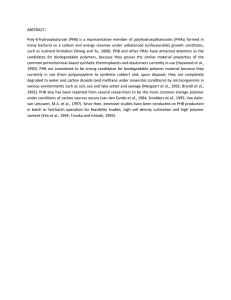
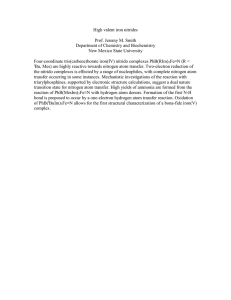
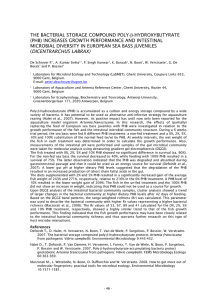
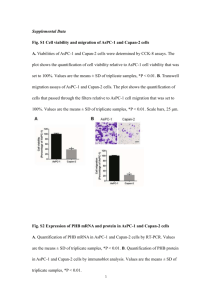

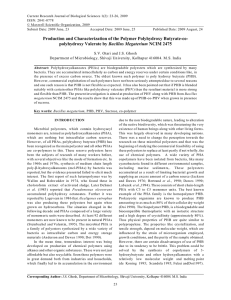
![Synthesis of a New Poly([R]-3](http://s2.studylib.net/store/data/018080759_1-471527a324cca1366c9dd8d198de8929-300x300.png)